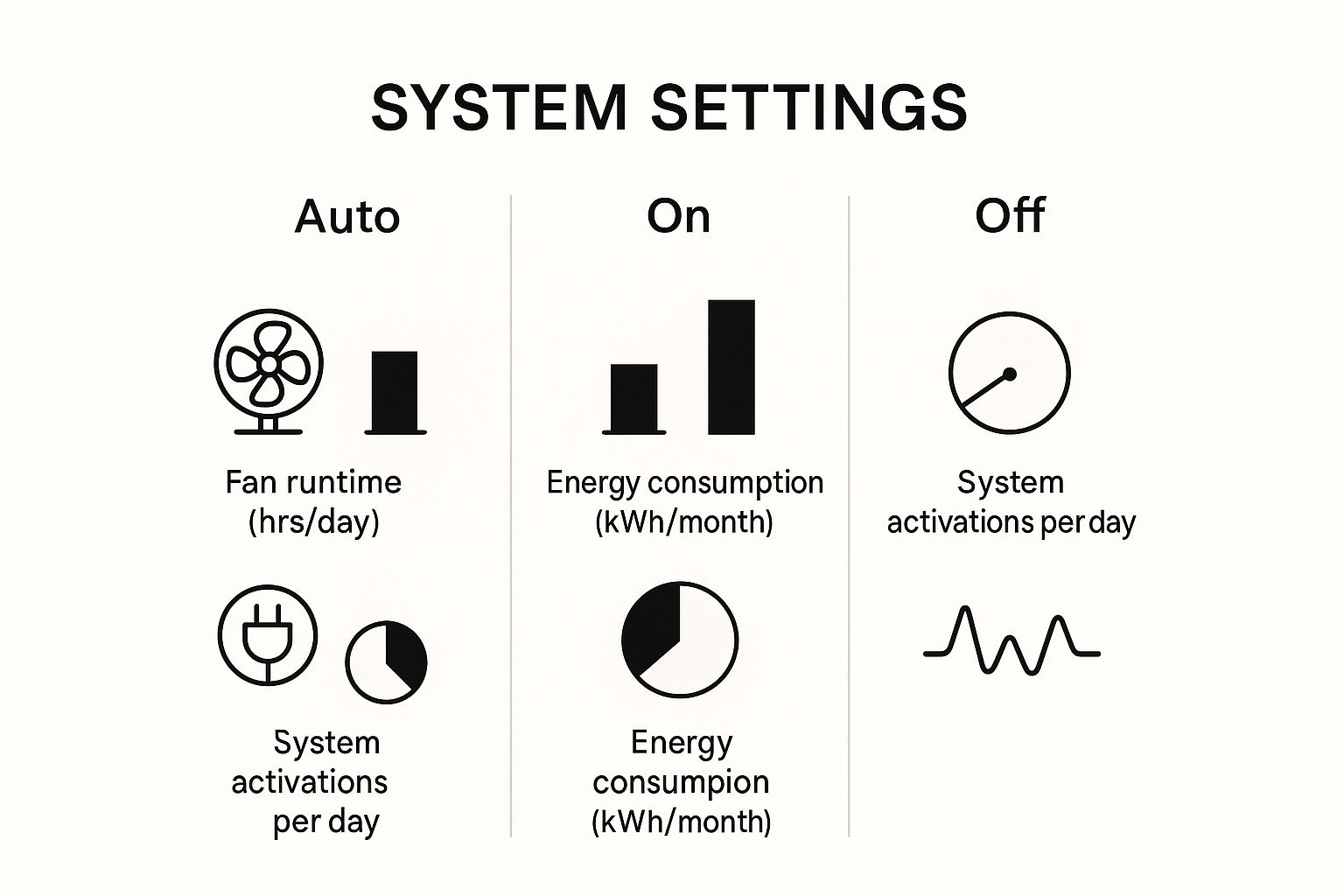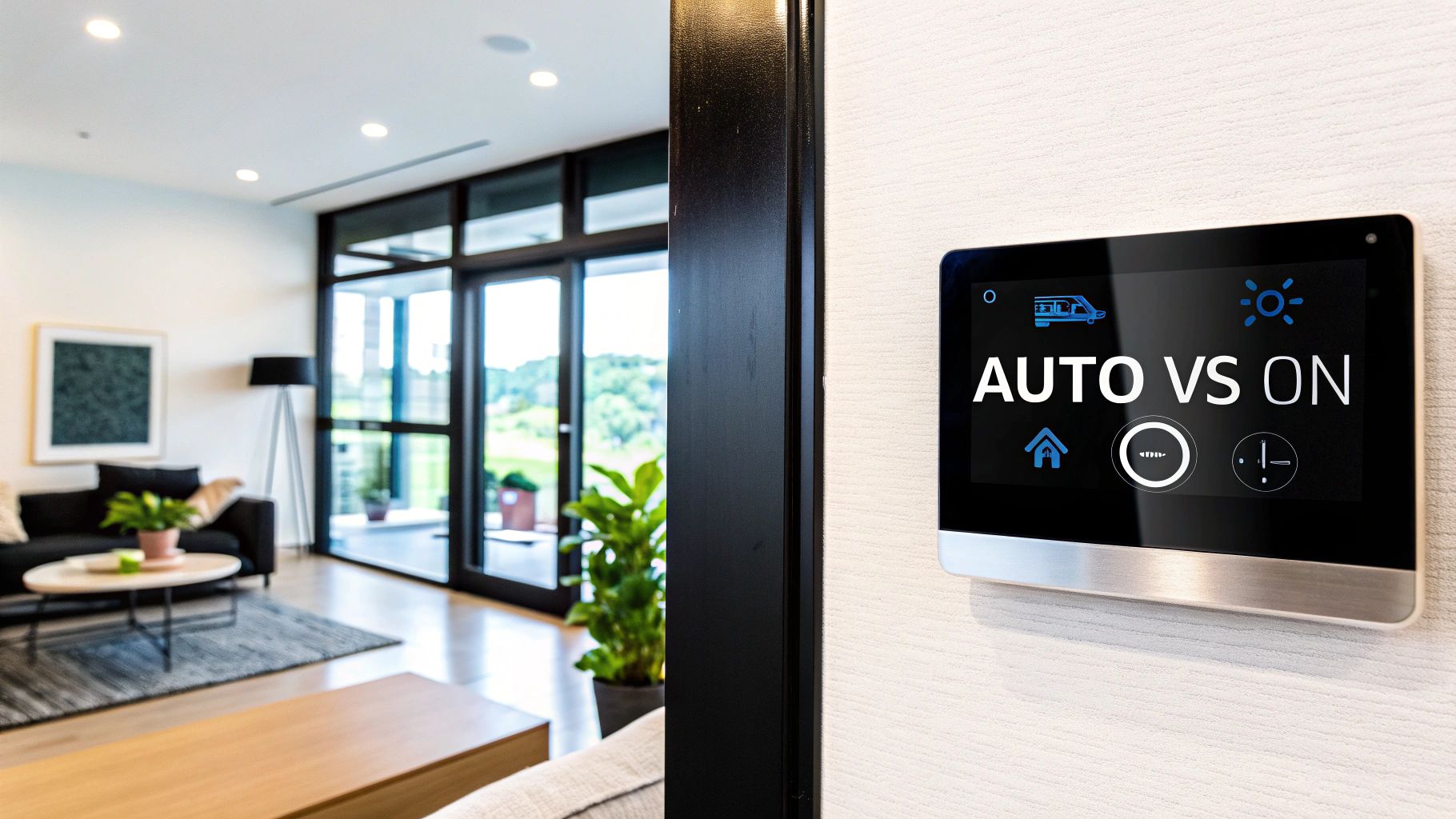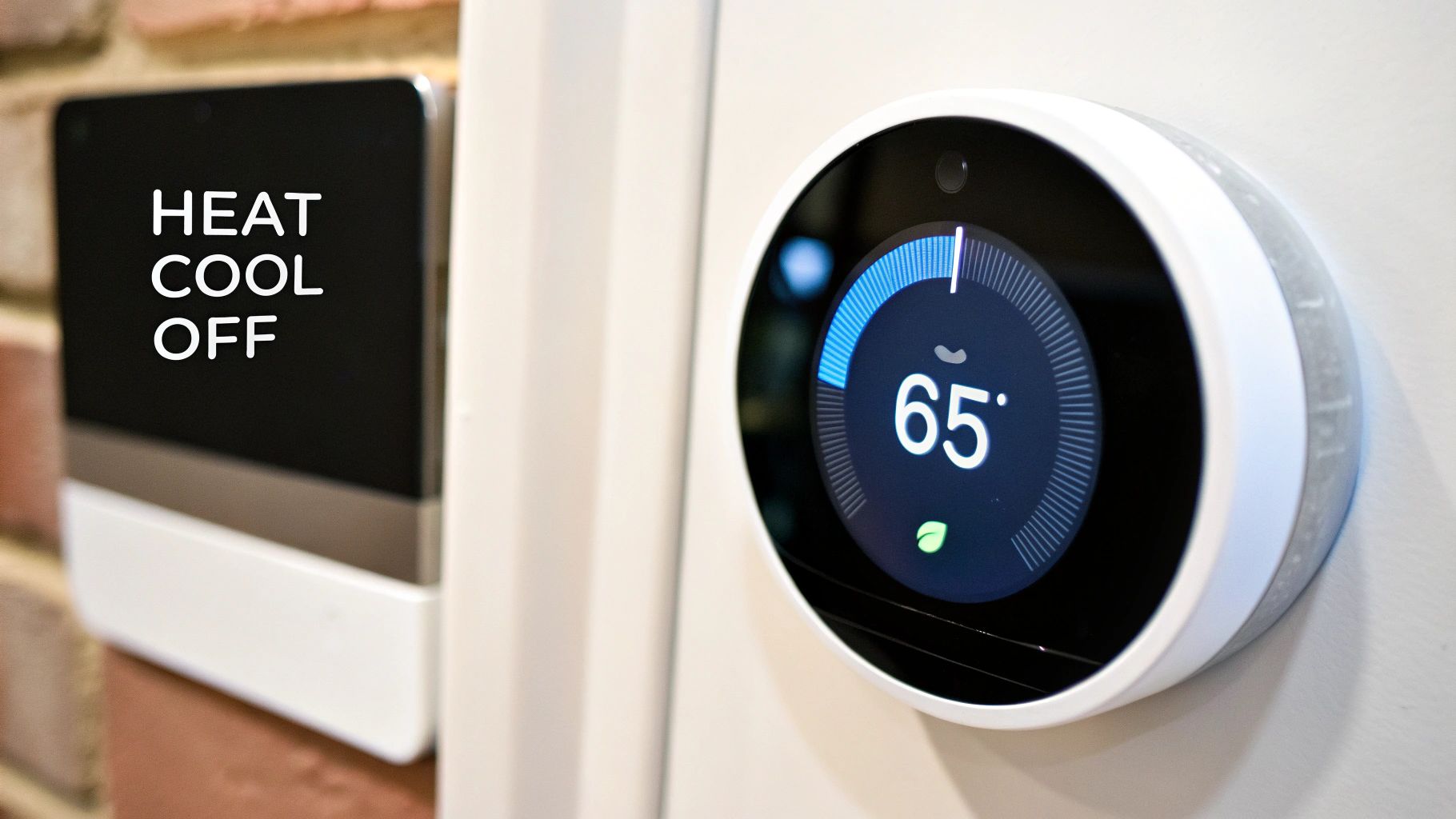What Does Auto Mean on Thermostat? (Guide & Benefits)
- shawncovenantaire
- Oct 10
- 10 min read
When you see the 'Auto' setting on your thermostat, think of it as putting your home’s climate on autopilot. It’s designed to cleverly switch between your heating and air conditioning to keep your home within a comfortable, pre-selected temperature range.

Unlike other modes that might run the fan constantly, 'Auto' only kicks the system on exactly when it's needed. This smart approach is the key to balancing everyday comfort with real energy savings.
Your Guide to Thermostat Auto Mode
The "Auto" setting is essentially the cruise control for your home’s temperature. You set it, and it works behind the scenes to maintain a steady environment without you having to constantly fiddle with the controls.
This mode is a game-changer for both comfort and efficiency. It ensures your HVAC system isn’t running unnecessarily, which is a core principle of modern climate control. If you want to dive deeper into how your whole system works together, our guide on the basics of air conditioning for homeowners is a great place to start.
Simply put, the 'Auto' setting tells your heating or cooling system to turn on only when the temperature drifts outside your desired range. This is a huge advantage for keeping utility bills in check. By minimizing wasted energy, it directly impacts your monthly spending and reduces wear and tear on your equipment.
Auto vs. On vs. Off at a Glance
So, how does 'Auto' stack up against the other settings? The main difference comes down to when the system's fan runs and when the heating or cooling engages. Let's break it down.

As you can see, the 'Auto' mode drastically cuts down on fan runtime and overall energy use when compared to leaving the fan in the 'On' position. This simple choice has a real, measurable impact on your utility bills and the longevity of your HVAC system.
To give you an even clearer picture, here’s a quick comparison of what each mode does.
Thermostat Mode Quick Comparison
Mode | Fan Operation | Heating/Cooling Operation |
|---|---|---|
Auto | The fan runs only when heating or cooling is active. | The system automatically switches between heating and cooling to maintain the set temperature range. |
On | The fan runs continuously, 24/7, regardless of temperature. | Heating or cooling will still activate when needed, but the fan never stops. |
Off | The fan is off. | The entire heating and cooling system is completely off and will not activate. |
Cool | The fan runs only when the A/C is actively cooling. | Only the air conditioning will turn on when the room temperature rises above your set point. |
Heat | The fan runs only when the furnace is actively heating. | Only the heat will turn on when the room temperature drops below your set point. |
This table really highlights the unique, hands-off benefit of the 'Auto' mode. It's the only setting that handles both heating and cooling without you needing to manually switch between modes as the seasons change.
Comparing the Auto and On Fan Settings

One of the most common questions we get from homeowners is about the difference between the 'Auto' and 'On' fan settings. It seems like a simple switch, but your choice makes a big difference in your home's comfort, energy bills, and even the health of your HVAC system. Let's clear up any confusion.
When your fan is set to 'On', it does exactly what it sounds like: it runs nonstop, twenty-four hours a day. You'll hear that constant, low hum from your vents as air circulates, regardless of whether your furnace or air conditioner is actually heating or cooling at that moment.
On the other hand, the 'Auto' setting is the smart choice. It syncs the fan's operation directly with your heating and cooling cycles. The fan only kicks on when your system is actively working to reach the temperature you've set. Once it hits that target, both the fan and the system power down until they're needed again.
How Each Setting Affects Your Home
Choosing between 'Auto' and 'On' creates two very different environments inside your home. Understanding these differences will help you decide which setting best fits what you need right now, whether that's saving money or boosting air circulation.
The 'Auto' setting is easily the most energy-efficient choice for day-to-day use because it stops the fan from running when it doesn't need to. This simple selection can lead to a noticeable drop in your monthly utility bills, especially during the peak of summer or winter.
Deciding which mode is best involves a few trade-offs. Let's break down how they stack up in the key areas of your home's climate control. For an even deeper dive, check out our complete guide explaining the thermostat fan 'On' or 'Auto' setting.
Feature | Auto Setting | On Setting |
|---|---|---|
Energy Consumption | Lower; the fan only runs when heating or cooling is active. | Higher; the fan runs constantly, increasing electricity usage. |
Air Filtration | Intermittent; air is only filtered during heating and cooling cycles. | Continuous; air constantly passes through the filter, which may help with allergens. |
Equipment Lifespan | Longer; less strain is placed on the fan motor. | Shorter; constant operation leads to increased wear and tear. |
Humidity Control | More effective; allows moisture to drain properly from AC coils. | Less effective; constant airflow can re-evaporate moisture into the air. |
Understanding Your Other Thermostat Modes

Beyond the fan settings of 'Auto' and 'On', your thermostat has a few other key players you need to know: 'Heat', 'Cool', and 'Off'. Getting a handle on these modes gives you total command over your home's climate, letting you adapt to any weather with the simple push of a button.
Think of these modes as specialists, each designed for a specific job. They are the individual tools in your climate control toolkit, perfect for times when you need a precise function instead of an all-in-one solution.
Dedicated Climate Control Modes
The 'Heat' and 'Cool' modes are pretty straightforward. When you select 'Heat', your system will only kick on the furnace to produce warm air when the temperature dips below your setpoint. It won't switch on the air conditioner, no matter how toasty it gets inside.
On the flip side, the 'Cool' mode does the exact opposite. It exclusively runs your air conditioner when the indoor temperature climbs above your setting, completely ignoring any drops in temperature. To really get the most from these settings, check out our guide on how to program a thermostat to save money and boost efficiency.
A common mistake we see is using the 'Auto' mode when 'Heat' or 'Cool' would be a much better fit. In the middle of winter, for instance, setting the mode to 'Heat' prevents your system from accidentally switching to AC on a surprisingly sunny afternoon. This ensures you get consistent warmth and better efficiency.
Finally, the 'Off' setting does exactly what you'd expect: it completely shuts down your HVAC system, fan and all. This is the perfect choice for those beautiful, mild spring or fall days when you can just open the windows and enjoy the fresh air without needing any help from your furnace or AC.
It's fascinating to see how these simple devices are part of a bigger picture. To understand how they fit into a more connected home, exploring a comprehensive guide to smart home technology can be really insightful.
The Real Benefits of Using the Auto Setting
So, why do we almost always recommend leaving your thermostat on 'Auto'? It’s simple. This smart mode delivers some pretty serious perks that you'll notice in your wallet and your daily life, boiling down to two huge wins: major energy savings and unwavering comfort. Think of it as the simplest “set it and forget it” trick for your home’s climate.
The logic is straightforward: by only running your HVAC system when it’s actually needed, 'Auto' mode cuts out all the wasted energy. This isn't just a few cents here and there; it adds up to real money off your monthly utility bills. It’s like turning off the lights when you leave a room, the system takes a break when the job is done, saving power.
Maximize Your Energy Savings
The number one reason to switch to 'Auto' is efficiency. A fan that runs 24/7 is a quiet energy hog, consuming a surprising amount of electricity and tacking unnecessary costs onto your bill. The 'Auto' setting puts a stop to this by making sure the fan only runs when your system is actively heating or cooling.
This small change has a huge ripple effect. Believe it or not, thermostatically controlled systems are responsible for roughly 50% of the total electricity demand in the United States. When you use the 'Auto' setting, you're doing your part to lower that demand, which helps reduce overall greenhouse gas emissions.
Using the 'Auto' setting is the single most effective way to lower your HVAC energy use without sacrificing comfort. Your system works smarter, not harder, leading to consistent savings month after month.
Enhance Home Comfort and System Longevity
Beyond the savings, the 'Auto' setting just makes your home feel better. It eliminates the constant drone and persistent drafts that come with a fan that never quits. Between cycles, the air is still and quiet, letting you enjoy a more peaceful environment.
There’s another hidden benefit: less wear and tear. When the fan motor isn't running around the clock, it lasts longer. Fewer run hours can actually extend the life of your entire HVAC system, pushing back the need for costly repairs or a full replacement.
Of course, to get the most out of any setting, your system needs to be in good shape. That means things like regular HVAC system cleaning are non-negotiable. And if you're looking to take efficiency and control to the next level, our guide on the unmissable benefits of smart thermostats is a great next step.
When to Use a Different Thermostat Setting
While the 'Auto' setting is a fantastic workhorse for everyday efficiency, some situations just call for a different tool. Knowing when to manually switch modes gives you total control over your home's comfort and your system's performance, no matter what's happening inside or out.
Think about it this way: after you’ve cooked a big, aromatic meal, you want those food smells gone, fast. Flipping the fan to 'On' is the perfect trick. The continuous airflow helps clear out lingering odors and circulates fresh air much quicker than waiting for the system to kick on by itself. The same idea works wonders for allergies, as constantly running the fan keeps air moving through your HVAC filter to trap more dust, pollen, and dander.
Adapting to Extreme Weather
During the dead of winter or the peak of a summer heatwave, relying on 'Auto' can be less effective. In those moments, you don't need your system guessing between heating and cooling; you just need one or the other, running consistently.
During a Heatwave: Set your thermostat to 'Cool'. This locks in your air conditioner and stops the system from accidentally switching to heat if a cool night causes the indoor temperature to dip for a moment.
During a Cold Snap: Switch the mode over to 'Heat'. This ensures only your furnace or heat pump will run, delivering steady warmth without any chance of the AC kicking on during a surprisingly sunny afternoon.
This targeted approach prevents the system from cycling between modes when it doesn't need to, which saves energy and reduces unnecessary wear and tear on your equipment. Finding that sweet spot for your thermostat is also a huge part of the puzzle, and you can learn more in our guide on what temperature to set your thermostat for big savings.
A common mistake is leaving the thermostat in 'Auto' mode all year without thinking about the season. In the winter, setting it to 'Heat' is almost always the most efficient choice, just as 'Cool' is the clear winner for summer.
Got Questions About Thermostat Auto Mode?
Even after you get the hang of what the "Auto" setting is all about, a few specific questions tend to bubble up. Let's tackle the most common ones we hear from homeowners so you can feel completely confident using your thermostat.
Is It Better to Leave My Thermostat on Auto or On?
For just about everyone, 'Auto' is the way to go for daily use. It's far more energy-efficient and puts less wear and tear on your HVAC system. Why? Because it only runs the fan when your system is actively heating or cooling the air.
The 'On' setting is really for temporary situations. You might switch to 'On' to get the air moving and help your filters catch more allergens during peak allergy season. It’s also great for quickly clearing out cooking smells after a big meal.
Does the Auto Setting Really Save Money?
Absolutely, and it's one of the easiest ways to trim your energy bills. When the fan motor only kicks on when it's needed, you avoid the cost of having it run 24/7. Simple as that.
Those savings might seem small day-to-day, but they really add up over a year, especially during those brutal summer months or a chilly winter.
The whole point of the 'Auto' setting is efficiency. Your HVAC system works smarter, not harder, which translates directly to lower energy use and more money in your pocket.
Why Is My Auto Mode Not Working Correctly?
If 'Auto' mode is acting up, the first thing to check is your temperature settings. Most modern thermostats need a bit of a buffer between your heating and cooling setpoints, usually 3-5 degrees, to work properly.
When the setpoints are too close, the system can get "confused" and won't activate either mode. If adjusting the temps doesn't fix it, the problem could be a faulty thermostat, bad wiring, or an issue with your HVAC system's control board. If a quick settings check doesn’t do the trick, it’s time to call a pro.
Can I Use Auto Mode in Both Winter and Summer?
Yes! That's the beauty of it. 'Auto' mode is designed for year-round, set-it-and-forget-it convenience. In the summer, it will turn on the AC whenever the house gets warmer than your cooling setpoint.
Come winter, it flips the script, firing up the furnace when the temperature dips below your heating setpoint. This is especially handy in the spring and fall when you might need a touch of heat in the cool morning but some AC by the afternoon.
When your thermostat settings aren't enough to solve a problem, you need experts you can trust. Covenant Aire Solutions offers professional HVAC services across Tucson and the surrounding areas. If you're experiencing issues with your system or want to ensure it's running at peak efficiency, contact us today for reliable, honest service.
